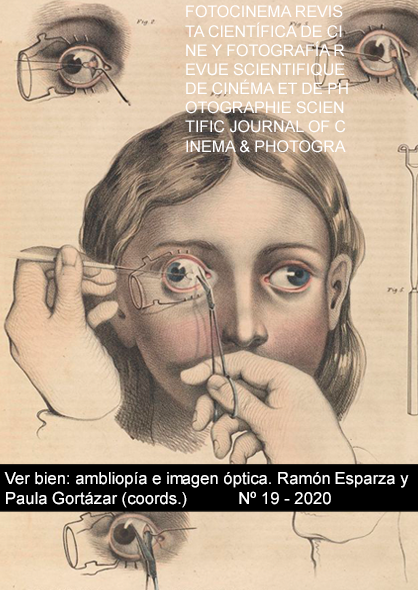Caligula (1979), erotic cinema or pornographic cinema?
DOI:
https://doi.org/10.24310/Fotocinema.2019.v2i19.6658Keywords:
Erotic Cinema, Caligula, Film Interpretation, Tinto BrassAbstract
The evolution of cinema has been triggering different types of film genres, and is that among all existing genres, there is a genre that has been a bit removed from the main lines of research in film, and therefore, does not have a large volume of literature that can suppose a good scientific base to continue growing academically speaking. The controversy between erotic and pornographic cinema has been present throughout the history of cinema, both genres being badly seen. For this we have developed an interpretive process accompanied by a file to analyze the selected scenes. Tinto Brass makes an exquisite use of voyeurism in the spectator, showing sex as an artistic way to show the reality on the big screen of his work Caligula. Therefore in the viewer gets reflected and meditate on the great difference between the contemplative enjoyment of a nude or a sexual relationship with broad dramatic, aesthetic and human meanings. With all this, finally Caligula can be classified as softcore cinema.
Downloads
Metrics
Publication Facts
Reviewer profiles N/A
Author statements
Indexed in
-
—
- Academic society
- N/A
- Publisher
- Universidad de Málaga
References
Aranda López, F. (2015). El cine del destape (II): Erotismo y pornografía desde los inicios del cine hasta la década de 1960. Mito. Revista Cultural. Recuperado de http://revistamito.com/el-cine-del-destape-ii-erotismo-y-pornografia-desde-los-inicios-del-cine-hasta-la-decada-de-1960
Arce, J. (2014): Con “S” de sexo. Representaciones musicales en el cine erótico de la transición. Quaderns. 9.
Ares, L. y Pedraz Poza, S. A. (2011): Sexo, poder y cine. Relaciones de poder y representaciones sexuales en los nuevos relatos pornográficos. ICONO 14, Año 9, Esp., 98-119
Arroyo Martínez, L. (2010). El erotismo literario en las adaptaciones cinematográficas: Estudio de siete ejemplos. Cauce. Revista internacional de Filología, Comunicación y sus Didácticas. 32
Bordwell, D. (1995). El significado del filme. Barcelona: Paido?s.
Calleja, P. (2013). Cine caliente. Teia?, Barcelona: Ma Non Troppo.
Carmona, L. (2010). Cine ero?tico a la europea. Madrid: T & B.
Casetti, F., y Di Chio, F. (1994). Co?mo analizar un film. Barcelona: Paido?s.
Forshaw, B. (2015). Sex and Film. The Erotic in British, American and World Cinema. Nueva York: Palgrave Macmillan (Edición Ebook)
García Gómez, F. (2017). Sexo y erotismo en el cine: lo que ha llovido desde El beso. Fotocinema. Revista científica de cine y fotografía, 15, 5-11.
Gómez Tarín, F. (2006). El análisis del texto fílmico. Portugal: Universidade da Beira Interio.
González Caldito, J. (2015). Cadenas, poder y pornografía. Mito. Revista Cultural. Recuperado de http://revistamito.com/cadenas-poder-y-pornografia
Gubern, R. (2005). La imagen pornográfica y otras perversiones ópticas. Barcelona: Anagrama.
Lipkau Henríquez, E. (2009). La mirada erótica. Cuerpo y performance en la antropología visual. ANTÍPODA. 9, 231-262
Malpartida Tirado, R. (2012). El erotismo, de la novela al cine: el caso de Bigas Luna. Analecta Malacitana. Electrónica 32.
Mendíbil Blanco, A., García García, F. y García Guardia, M. L. (2017). Narratología porno. Una lectura semiótica de Tras la puerta verde. Fotocinema. Revista científica de cine y fotografía. 15, pp. 155-177. Disponible en: http://www.revistas.uma.es/index.php/fotocinema/article/view/3504/3215. doi:http://dx.doi.org/10.24310/Fotocinema.2017.v0i15.3504.
Reidar, D. (2013). Love in Motion. Nueva York: Wallflower Press.
Rodrigues, N. S. (2014). A Antiguidade no cinema: Caligula de Tinto Brass e Bob Guccione (1979). Boletim de Estudos Clássicos, 59, 137-152,
Rodriguez Centeno, J.C. y Corredor, J. (1997). Publicidad y cine erótico en la prensa de la transición. Questiones Publicitaria. 6
Rojas Bez, J. (1997). Erotismo, pornografía y cine. Chasqui. Revista Latinoamericana de Comunicación. 57, 47-50
Rouner, J. (2014). What It's Really Like To Write Porn For A Living. Your Tango. Recuperado de https://www.yourtango.com/2014224426/what-its-really-like-to-write-porn-for-a-living
Schaefer, E. (1999). Bold! Daring! Shocking! True! A History of Exploitation Films, 1919–1959. Durham: Duke University Press.
Downloads
Published
How to Cite
Issue
Section
License
All contents published in Fotocinema Revista científica de cine y fotografía are protected under the Creative Commons Attribution-NonCommercial-ShareAlike 4.0 International (CC BY-NC-SA 4.0) license. All about this license is available in the following link: <http://creativecommons.org/licenses/by-nc-sa/4.0>
Users can copy, use, redistribute, share and exhibit publicly as long as:
- The original source and authorship of the material are cited (Journal, Publisher and URL of the work).
- It is not used for comercial purposes.
- The existence of the license and its especifications are mentioned.
There are two sets of authors’ rights: moral and property rights. Moral rights are perpetual prerogatives, unrenounceable, not-transferable, unalienable, imprescriptible and inembargable. According to authors’ rights legislation, Fotocinema. Revista científica de cine y fotografía recognizes and respects authors moral rights, as well as the ownership of property rights, which will be transferred to University of Malaga in open access. The property rights are referred to the benefits that are gained by the use or the dissemination of works. Fotocinema. Revista científica de cine y fotografía is published in an open access form and it is exclusively licenced by any means for doing or authorising distribution, dissemination, reproduction, , adaptation, translation or arrangement of works.
Authors are responsable for obtaining the necessary permission to use copyrighted images.














13.png)



